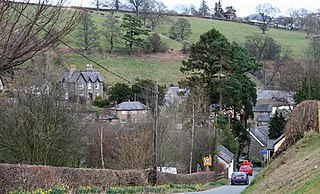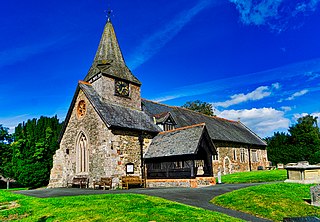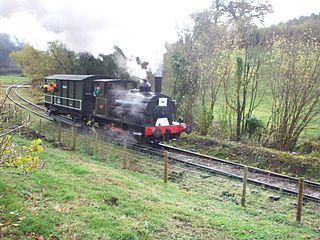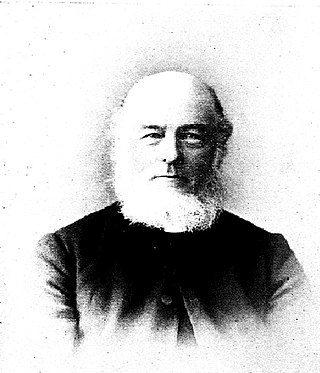
Powys is a county and preserved county in Wales. It borders Gwynedd, Denbighshire, and Wrexham to the north; the English ceremonial counties of Shropshire and Herefordshire to the east; Monmouthshire, Blaenau Gwent, Merthyr Tydfil, Caerphilly, Rhondda Cynon Taf, and Neath Port Talbot to the south; and Carmarthenshire and Ceredigion to the west. The largest settlement is Newtown, and the administrative centre is Llandrindod Wells.

Oswestry is a market town, civil parish and historic railway town in Shropshire, England, close to the Welsh border. It is at the junction of the A5, A483 and A495 roads.

Welshpool is a market town and community in Powys, Wales, historically in the county of Montgomeryshire. The town is four miles from the Wales–England border and low-lying on the River Severn. The community, which also includes Cloddiau and Pool Quay, has a population of 6,664, with the town having 5,948. There are many examples of Georgian architecture within the town. Powis Castle is located to the north.

Llanrhaeadr-ym-Mochnant is a village, community and an ecclesiastical parish in the extreme north of Powys, Wales; about 9 miles west of Oswestry and 12 miles south of Llangollen, on the B4580. It lies near the foothills of the Berwyn mountains on the river Rhaeadr. At the top end of the valley is the Pistyll Rhaeadr waterfall, one of the Seven Wonders of Wales in the old rhyme. One mile north of the town is the hill Moel Hen-fache. The community includes the hamlet of Llanarmon Mynydd Mawr.

Llanymynech is a village and former civil parish straddling the border between Montgomeryshire/Powys, Wales, and Shropshire, England, about 9 miles (14 km) north of the Welsh town of Welshpool. The name is Welsh for "Llan of the Monks". The village is on the banks of the River Vyrnwy, and the Montgomery Canal passes through it.

The Cambrian Heritage Railways is a heritage railway company, trust and society based at both Llynclys and Oswestry in its restored Oswestry railway station, Shropshire, England.

The English county of Shropshire has a fairly large railway network, with 19 National Rail stations on various national lines; there are also a small number of heritage and freight lines, including the famous heritage Severn Valley Railway running along its eastern border with Worcestershire.

Kinnerley is a small village in Shropshire, England. It lies between the neighbouring villages of Dovaston and Pentre and the nearest town is Oswestry. To the north is the village of Knockin.

Llynclys ) is a small village in Shropshire, England, in the civil parish of Llanyblodwel. It lies north of Pant at the crossroads of the A483 and B4396, where there are several houses and a pub, the White Lion.

Llansantffraid-ym-Mechain is a large village in Powys, Mid Wales, close to the border with Shropshire in England, about 7 miles (11 km) south-west of Oswestry and 8 miles (13 km) north of Welshpool. It is on the A495 road and is at the confluence of the River Vyrnwy and the River Cain. The population as of the 2011 UK census was 1,415. The community includes the village of Deuddwr and several hamlets.

The Tanat Valley Light Railway (TVLR) was a 15-mile (24 km) long standard gauge light railway. It ran westwards from Llanyblodwel in Shropshire, about 5 miles or 8 km southwest of Oswestry. It crossed the Wales–England border and continued up the Tanat Valley, terminating at Llangynog in Powys. It opened in 1904, providing access to a fairly remote area, and transport facilities for slate production and agriculture.

Selattyn is a village and former civil parish, now in the parish of Selattyn and Gobowen, in the Shropshire district, in the ceremonial county of Shropshire, England. It is on the England–Wales border, close to Oswestry. In 1961 the parish had a population of 1830. On 1 April 1967 the parish was abolished to form "Selattyn and Gobowen", part also went to Whittington.

Rev. Elias Owen MA, F.S.A. was a Welsh cleric and antiquarian whose works include The Old Stone Crosses of the Vale of Clwyd, 1886 and Welsh Folk-Lore, 1896.

Oswestry railway station is a Grade II listed heritage railway station in Oswestry, Shropshire, England. It was closed when passenger services were withdrawn in 1966. The station building today is used as commercial premises, although the Cambrian Railways Society are restoring it.

The Llanfyllin Branch was a railway line extension of the Oswestry and Newtown Railway to access the limestone resources within the Llanfyllin area; it opened in 1863.

St Michael the Archangel is a Grade I listed church in Llanyblodwel, in Shropshire, England. It has a spire of unusual shape and was designed in 1847–1856 by the vicar, John Parker.

Blodwell Junction railway station was a station in Llanyblodwel, Shropshire, England. The station opened on 18 April 1870 as Llanyblodwel before being renamed in 1904. The station closed to passengers on 15 January 1951 and closed completely on 6 January 1964. There is no trace of the station today.

Porthywaen Halt railway station was a station in Porth-y-waen, Shropshire, England, on the Tanat Valley Railway and the Potteries, Shrewsbury and North Wales Railway. The station opened in 1904 and closed in 1951. The short platform had a shelter and there was also signal box at the east end which controlled access to the quarry branches. Cambrian Heritage Railways has plans to re-open the station as part of its aim of reopening the line from Gobowen to Blodwel. The platform is still extant.

John Parker was a Welsh cleric and artist. Second son of Thomas Netherton Parker and his wife Sarah Browne of Sweeney Hall, Oswestry, Shropshire, he was educated at Eton College and Oriel College, Oxford. Author of poem "The Passengers: Containing, the Celtic Annals.", published 1831.
Llanyblodwel is a civil parish in Shropshire, England. It contains 49 listed buildings that are recorded in the National Heritage List for England. Of these, one is listed at Grade I, the highest of the three grades, one is at Grade II*, the middle grade, and the others are at Grade II, the lowest grade. The parish contains the village of Llanyblodwel and smaller settlements, and is otherwise rural. Most of the listed buildings are houses, farmhouses and farm buildings, many of which are timber framed and date from the 14th to the 17th century. The other listed buildings include a church, memorials, coffins and a sundial in the churchyard, a public house, a country house and associated structures, a former toll house, nine groups of lime kilns, a smelt flue chimney, two bridges, a pump, and a war memorial.






















